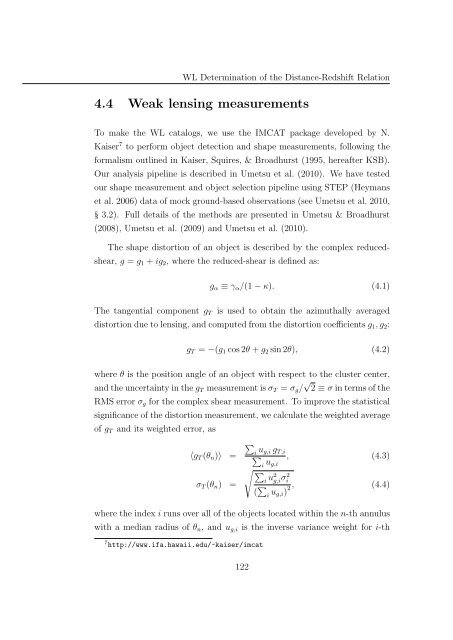Mass and Light distributions in Clusters of Galaxies - Henry A ...
Mass and Light distributions in Clusters of Galaxies - Henry A ...
Mass and Light distributions in Clusters of Galaxies - Henry A ...
You also want an ePaper? Increase the reach of your titles
YUMPU automatically turns print PDFs into web optimized ePapers that Google loves.
WL Determ<strong>in</strong>ation <strong>of</strong> the Distance-Redshift Relation<br />
4.4 Weak lens<strong>in</strong>g measurements<br />
To make the WL catalogs, we use the IMCAT package developed by N.<br />
Kaiser 7 to perform object detection <strong>and</strong> shape measurements, follow<strong>in</strong>g the<br />
formalism outl<strong>in</strong>ed <strong>in</strong> Kaiser, Squires, & Broadhurst (1995, hereafter KSB).<br />
Our analysis pipel<strong>in</strong>e is described <strong>in</strong> Umetsu et al. (2010). We have tested<br />
our shape measurement <strong>and</strong> object selection pipel<strong>in</strong>e us<strong>in</strong>g STEP (Heymans<br />
et al. 2006) data <strong>of</strong> mock ground-based observations (see Umetsu et al. 2010,<br />
§ 3.2). Full details <strong>of</strong> the methods are presented <strong>in</strong> Umetsu & Broadhurst<br />
(2008), Umetsu et al. (2009) <strong>and</strong> Umetsu et al. (2010).<br />
The shape distortion <strong>of</strong> an object is described by the complex reducedshear,<br />
g = g 1 + ig 2 , where the reduced-shear is def<strong>in</strong>ed as:<br />
g α ≡ γ α /(1 − κ). (4.1)<br />
The tangential component g T is used to obta<strong>in</strong> the azimuthally averaged<br />
distortion due to lens<strong>in</strong>g, <strong>and</strong> computed from the distortion coefficients g 1 , g 2 :<br />
g T = −(g 1 cos 2θ + g 2 s<strong>in</strong> 2θ), (4.2)<br />
where θ is the position angle <strong>of</strong> an object with respect to the cluster center,<br />
<strong>and</strong> the uncerta<strong>in</strong>ty <strong>in</strong> the g T measurement is σ T = σ g / √ 2 ≡ σ <strong>in</strong> terms <strong>of</strong> the<br />
RMS error σ g for the complex shear measurement. To improve the statistical<br />
significance <strong>of</strong> the distortion measurement, we calculate the weighted average<br />
<strong>of</strong> g T <strong>and</strong> its weighted error, as<br />
∑<br />
i<br />
〈g T (θ n )〉 =<br />
u g,i g<br />
∑ T,i<br />
, (4.3)<br />
i u g,i<br />
σ T (θ n ) =<br />
√ ∑<br />
i u2 g,i σ2 i<br />
( ∑ i u g,i) 2 , (4.4)<br />
where the <strong>in</strong>dex i runs over all <strong>of</strong> the objects located with<strong>in</strong> the n-th annulus<br />
with a median radius <strong>of</strong> θ n , <strong>and</strong> u g,i is the <strong>in</strong>verse variance weight for i-th<br />
7 http://www.ifa.hawaii.edu/~kaiser/imcat<br />
122
















